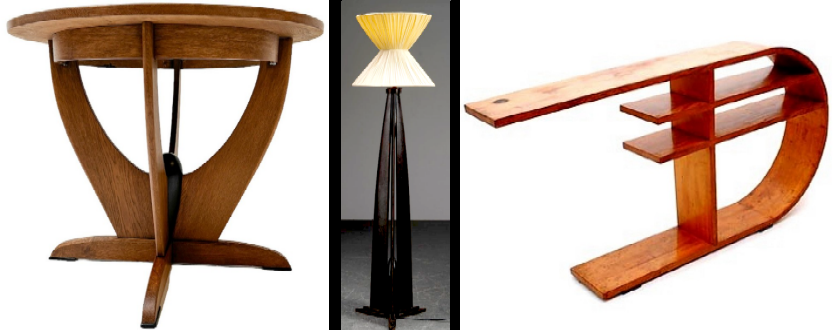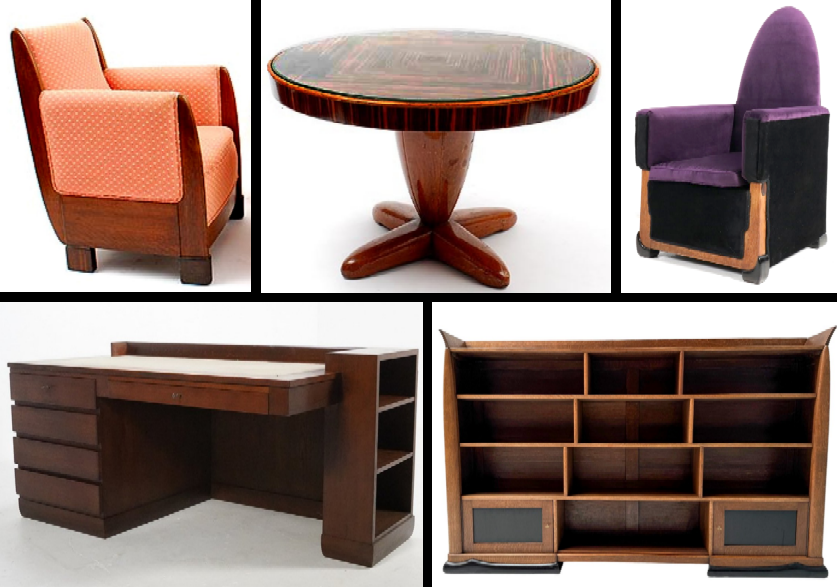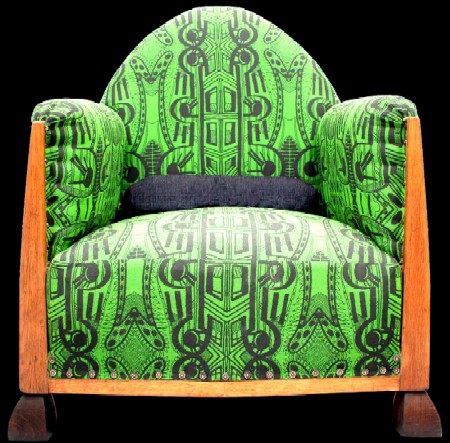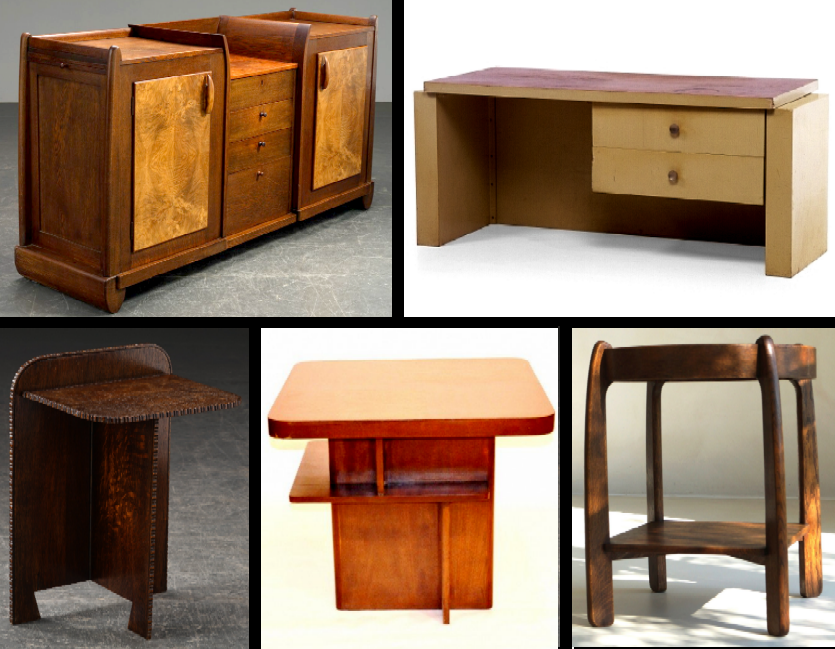
Paul Bromberg (1893 - 1949)

Paul Bromberg, Photo - Erwin Blumenfeld (Early 1930s)
Paul Bromberg (1893 - 1949) was born on July 12, 1893 in Amsterdam, Netherlands. His father owned a furniture store where he gained working experience. He took lessons from architect L. van Ishoven, becoming adept at design.
Bromberg established himself as an interior designer in Amsterdam in 1913. For the next five years, he designed furniture and rooms for clients. Little seems to be known about his work during this period, probably because he was just getting started and had smaller jobs.
He joined VANK (Nederlandsche Vereeniging voor Ambachts- en Nijverheidskunst - Dutch Association for Craft and Industrial Art) at the beginning of his career (likely in 1913) which was to have a large impact on his career. Their aim was promoting craft work and industrial design, with many of the founders interested in the changing focus of design to a new age of "truth, honesty, and realism" (a description aligned with Modernism) in the twentieth century. Founder Willem Penaat focused on artistic ownership and copyright. ("Nederlandsche Vereeniging voor Ambachts- en Nijverheidskunst", Wikipedia, gathered 4-18-25)
In April 1918, Bromberg displayed his work at the Exhibition of Crafts, Industry and Folk Art in Rotterdam as well as publishing his 'Thoughts on Interior Art' in the magazine Levende Kunst. These public efforts propelled his career and helped him to gain employment which would move it even further forward.
The same year Bromberg was hired to be the first designer ever employed by the department store Metz & Co. They had been buying most of their furnishings from an English company before he joined them. He became responsible for purchasing arts and crafts items for the store chain as well as producing a collection of furniture and accessories for them. Under Bromberg, Metz and Co. moved towards the contemporary Amsterdam School designs. As a furniture designer, he insisted that the items he created for Metz be marketed in a collection with his name on it, likely due to the influence of VANK. Traveling around Europe on behalf of the company kept him up on the latest design trends. He served as the head of the Arts and Crafts and Home Furnishings department until 1924.
 Paul Bromberg Designs for Metz & Co., From left - Table, Oak, 1918-24, Pamono; Bromberg, Lamp, Wood and Fabric, Metz and Co., 1918-24, Kader Design; Side Table, Rosewood, Metz and Co, 1918-24, Pinterest
Paul Bromberg Designs for Metz & Co., From left - Table, Oak, 1918-24, Pamono; Bromberg, Lamp, Wood and Fabric, Metz and Co., 1918-24, Kader Design; Side Table, Rosewood, Metz and Co, 1918-24, Pinterest
Bromberg moved from Metz Co. to the modern interior art department of H. Pander & Zonen, a company creating high-quality furnishings which offered customers contemporary design and offered advice on room design and color combinations. He designed room interiors as well as furniture for Pander. He initially continued in the style of furniture he had been designing for Metz Co. which relied primarily on the use of different woods to provide "decorative character". (Monique Teunissen, Paul Bromberg, Binnenhuisarchitect en publicist, 1987, p. 13) His designs focused on function rather than form - a facet of Modernism - generally eschewing excessive and unnecessary decoration.
 Paul Bromberg Designs for H. Pander and Zonen., From top left - Archairs and Table, Probably Oak with Fabric Upholstery, 1927, Botterweg Auctions; Lounge Chair Oak with Purple Upholstery, 1920s, Vintage; Rotating Top Table, Rosewood and Mahogany, 1931, Botterweg Auctionsl; Director's Desk, Oak with Fabric Top, 1920s, Pamono; Bromberg, Director's Desk, Oak with Fabric Top, 1920s, Pamono
Paul Bromberg Designs for H. Pander and Zonen., From top left - Archairs and Table, Probably Oak with Fabric Upholstery, 1927, Botterweg Auctions; Lounge Chair Oak with Purple Upholstery, 1920s, Vintage; Rotating Top Table, Rosewood and Mahogany, 1931, Botterweg Auctionsl; Director's Desk, Oak with Fabric Top, 1920s, Pamono; Bromberg, Director's Desk, Oak with Fabric Top, 1920s, Pamono
Bromberg created interior designs for a variety of rooms and home while at Pander. These included model rooms for the company in 1924, 1926, 1927, 1931 & 1932 as well as for Exhibitions, including one at Modern Interiors in 1927, the Modern Arts and Crafts exhibit in 1932 (both at the Stedelijk Museum) and the Contemporary Home Furnishings exhibition in 1928 in Tivoli. The model rooms were meant to show different design possibilities to Pander visitors. Bromberg redesigned some of the rooms suggesting that they were regularly updated to present the most modern styles. He also created designs for various VANK exhibitions between 1932 and 1936. He designed some commissioned rooms in homes in 1931 and 1932.
Bromberg was particularly interested in how color choice impacted a room design. He considered the color of the upholstery, floor coverings and accessories to be important to the overall design.

Vanity, Japanned Teak and Cherrywood, Pander and Zonen, c. 1927,
Christies
He often favored royal blue, red, soft yellow and soft green tones. Looking at Bromberg's room design style during this period, author Monique Teunissen notes,
Attention to the total spatial concept in combination with an efficient layout remained characteristic of Bromberg's interiors. He tried to achieve informality through 'organic' furnishing... In contrast to the old furnishing ideas, space was not seen as a sum of various factors, but as a total event. The use of furniture, based on external coherence through similar wood and detail applications, stood in the way of an optimal use of the space provided, especially in the new, smaller homes. Attention to the proportions, the character of the space, were an important factor for Bromberg, on which he could also base his use of colour, contrasting materials, wall layout and lighting treatment. (Teunissen, p. 21)
In late 1933, Bromberg left Pander to establish his own interior design company, setting up a workspace in the attic of his house. He began doing interior designs for Van Werven's carpentry using standardized furniture produced by companies such as Nederlandse Fabriek voor Betimmeringen v/h Gebr. Reens, J.A. Boskamp and Huizinga. Despite the Depression, he had enough business to require moving from his attic to a new apartment for himself in addition to setting up a model apartment to show clients. "Compared to the interiors and furniture he designed for Metz and Pander, designs from this period were more daring and less luxurious.... The furniture had to be affordable but comfortable." (Teunissen, p. 29) The public response to his work was very positive.
Bromberg also began designing theatre sets in 1934, creating designs for seven productions in both '34 and '35 and two in 1936 The arrival of movies created an attendance problem in the theater world, leading to a need for modern, innovative designs which could compete with those seen in movies. Resources and space for set storage were both limited, requiring ingenuity of Bromberg's part.

Armchair, Wood and Upholstery, Re-upholstered, c. 1920, Selency
1935 saw an increase in the number of commissions for Bromberg, which occupied all of his attention from 1936 through 1939. This is likely why he quit designing theater sets. His employers included homes, medical practices, businesses and even a concert hall - De Vereeniging in Nijmegen (1936). He also leveraged his experience at Pander designing Exhibition spaces for other companies. Among other displays, he was one of five interior designers selected to design the Dutch pavilion at the New York World's Fair of 1939-40.
Bromberg was in New York when the Second World War began, forcing him to remain there. While in the United States, he was given several interior design assignments as well as being employed by the Netherlands Information Bureau. He also spent time observing US construction methods on behalf of the Dutch government. He returned to the Netherlands in 1945 following the end of the war and resumed his consulting work. He continued to execute some commissions until his death in 1949.
Like many of the leading figures in the Art Deco and Modernist movements, Bromberg began teaching. In 1921 he began lecturing on interior design using lantern slides. He became the founding chairman of the first Circle of VANK in 1931, a group created to facilitate the exchange of ideas between members. The Circle regularly organized exhibitions on design. This led to the establishment of a museum for applied arts within the existing Stedelijk Museum. VANK was dissolved in 1941 to avoid compulsory membership in the institute created by the German occupying forces during World War II. When Bromberg returned to the Netherlands, he joined the organization which replaced VANK - the Association of Practitioners of the Bonded Arts (aKf), founded in 1946.
Bromberg also wrote copiously on the design, authoring ten books in addition to approximately 700 articles which appeared in various magazines, annuals and other books.
Sources Not Mentioned Above:
"Paul Bromberg" Geni website, gathered 4-17-25
"Paul Bromberg", Kunstbus website, gathered 4-18-25
Original Facebook Group Posting
 BrombergFurniture Designs, From left - Sidboard, Use of Different Woods, 1920s-30s, Pander, Kader Design;; Bureau, c. 1935, Stedelijik Museum; Folding Side Table, Wood, 1930s, Vintage; Side Table, Wood, Fer Semey for Pander, 1930s, Vintage; Side Table, Pander and Zonen, 1920s, Vintage
BrombergFurniture Designs, From left - Sidboard, Use of Different Woods, 1920s-30s, Pander, Kader Design;; Bureau, c. 1935, Stedelijik Museum; Folding Side Table, Wood, 1930s, Vintage; Side Table, Wood, Fer Semey for Pander, 1930s, Vintage; Side Table, Pander and Zonen, 1920s, Vintage